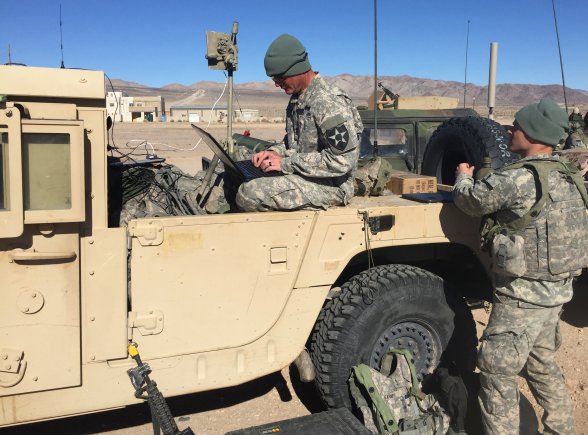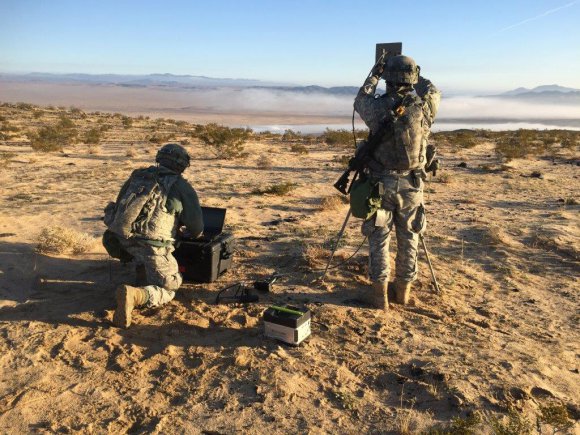
WASHINGTON: This afternoon, Army generals gathered to begin designing a new kind of unit, a tactical cyber/electronic warfare detachment, whose first experimental exercise overseas could be as early as next year. For the first time since the Cold War, at least a small part of the Army could have radio and radar jamming capabilities to match the Russians, who’ve used EW to devastating effect in Ukraine. For the first time ever, it could have hackers on the battlefield.

Brig. Gen. Patricia Frost.
“The mission analysis just starts today,” Brig. Gen. Patricia Frost told reporters this morning. “We’re doing the kickoff meeting today with all the different stakeholders”: program managers, officers from the cyber/signal and intelligence centers, and more. Frost herself heads the brand-new cyber directorate (which also covers EW) of the Army’s headquarters staff in the Pentagon.
There’ve already been multiple wargames with experimental cyber/EW detachments over the last two years, but today’s meeting will begin the analysis to design a deployable, operational unit, using equipment that’s either off-the-shelf or from existing programs of record. “I’m hoping by January/February I can give you more (detail),” Frost told the Association of Old Crows conference here.
Those early-2017 decisions potentially include “a certain capability that we’re looking at procuring” with the Army Rapid Capabilities Office, another new organization, Frost said. (She didn’t want to get ahead of the RCO’s decision-making by giving details). While the Army’s official program of record doesn’t deliver a new offensive jammer until 2023, the service is now looking at both accelerating elements of official programs and buying gear off the shelf, if only as an interim capability to train and experiment with. “With the analysis that we’re doing over the next three to six months, we’ll rack and stack what are the capabilities that exist today that can allow us to experiment,” Frost told reporters.
That means the Army will be making critical decisions in the February-May 2017 timeframe, with the actual unit starting to take shape over the summer. Said Frost, “I know it’s really aggressive, but I think that’s where we need to be.”
“Before, it was just a concept, it was PowerPoint,” Frost told the conference. “Now we’re looking at timelines, how do we actually get to achieving that objective, and having an organization, people, and training by this summer.” Initial field exercises might be held at the National Training Center at Fort Irwin, California or White Sands Missile Range near Fort Bliss, Texas.

Cyber soldiers from the 780th Military Intelligence Brigade in the desert at the National Training Center.
By 2018 — possibly even in 2017 — Frost wants the first cyber/EW detachment exercising with one of the geographic Combatant Commands around the world. Both Army and COCOM leaders are pushing for this to happen ASAP, she said. (She didn’t say where, but the Russian threat to the Baltic States makes European Command the top contender). This would be a real-world mission, but it would also constitute a field test of the detachment, informing Army decisions on how to improve the unit and whether to make more of them.
“Once we experiment with it,” Frost said, “the leadership needs to decide, ok, what could we with that, and what would be an element that would be at brigade, division, or corps, because those different sizes matter.” The wargames so far have experimented with cyber/EW teams directly supporting combat brigades, which have the most urgent need for support, but which also don’t have as much staff capacity to manage yet another high-tech asset.
When and if the Army decides to field more cyber/EW detachments, that is when money will become an issue. “I am not concerned about the resourcing today,” Frost told the conference. The first detachment is coming out of hide, repurposing existing funds, equipment, and personnel. “I don’t want to bring a bill to the Army,” Frost told reporters, “(so) what do we do with the resources that we have that we can reorganize to effect change today?”
Buying more EW equipment isn’t Frost’s priority. The Army has seen plenty of high-tech gear rushed to Iraq and Afghanistan since 9/11, only to languish because no one knew how to use it or appreciated its value. “I am more concerned about the reorganization and the training of the personnel,” Frost said. “If you don’t have the people and the training…that materiel is just going to sit somewhere in a container.”
Likewise on the cyber front, Frost considers the human element more important than the legal and policy complexities of who has authority to do what mission in cyberspace, which has long bedeviled cyber operations. The first priority has to be giving commanders a way to understand what’s happening in cyberspace and visualize it so they can make good decisions, she said. Without such “situational awareness,” you’re fighting blind and probably shouldn’t be thinking about offensive cyber operations, which are what really create legal nightmares.
In essence, Frost is saying let’s figure out the basics first, then use that first operational unit to inform what we need to do in terms of new legal authorities and expensive new equipment.
“I think we have the ability to organize, train, and equip, (and) bring an operational capability to the force,” Frost said. “We do that with the resources we have, and then… in two to three years, we can say we know the direction of the type of growth we might need.”
France, Germany ink deal on way ahead for ‘completely new’ future European tank
Defense ministers from both countries hailed progress on industrial workshare for a project that they say “will be a real technological breakthrough in ground combat systems.”


























